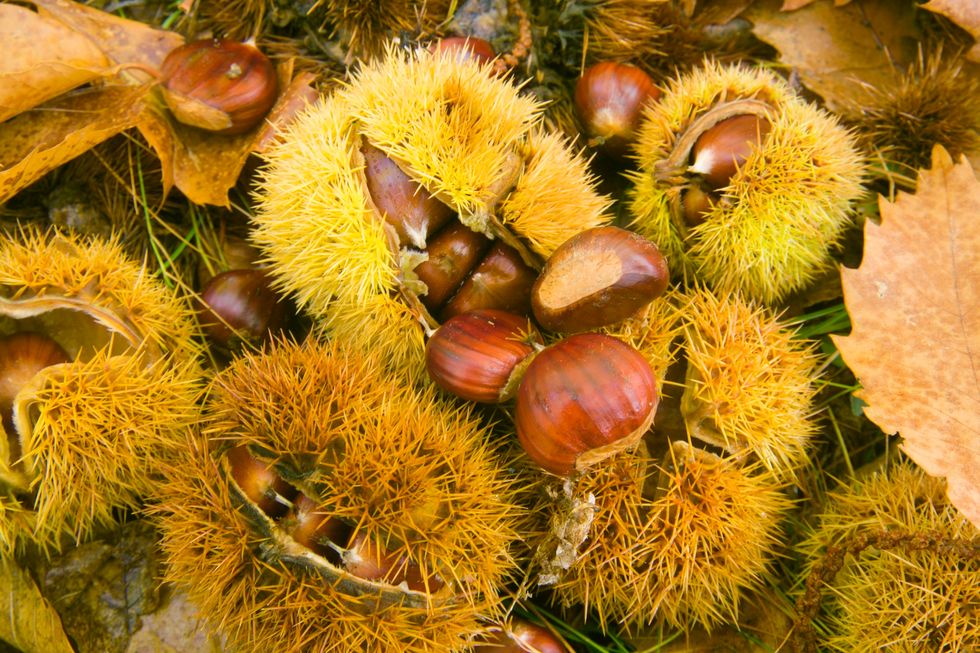
Roasted, boiled, braised, dried, in sweet or savory recipes: chestnuts are a real (and delicious) panacea for health!
October: it's time for chestnuts (and chestnuts!). Thanks to an unexpectedly sunny autumn and the desire to be outdoors, many have reached the woods armed with baskets, bags and sacks, to conquer the most delicious booty of the season. Protected by the hedgehog and hidden by a thick carpet of leaves, chestnuts are divided into two groups: those of small size and dark brown color, crushed on one side with very tasty pulp and the browns, larger and with the characteristic heart shape, with light brown streaked peel that encloses a sweet pulp.
Much appreciated in the kitchen for its versatility, which makes it perfect for sweet and savory preparations, chestnuts are a true concentrate of vitamins and minerals but the good reasons for choosing this autumn fruit don't end there!
Energy and good mood
The chestnut has a high nutritional power and is an important source of energy, much needed this season. The high caloric rate is partly due to the low amount of water - chestnuts are made up of 50% water - and to the richness of complex carbohydrates such as starch. Moreover, thanks to the magnesium that stimulates the nervous system, it also seems to promote a good mood.
Toccasana for mind and body
Small fruit but beneficial for the whole organism! In fact, chestnuts are good for the mind, muscles and bones thanks to the B complex vitamins and phosphorus, of which it is particularly rich, which help to maintain high concentration. It also contains a large amount of potassium, useful for strengthening muscles and reducing rheumatic pains, and sulfur which strengthens the bones and at the same time purifies the body. It is recommended during pregnancy because it is rich in folic acid, a B vitamin important in the prevention of fetal malformations. Thanks to the iron content, it also helps improve blood circulation.
360º goodness
Chestnut is a precious source of fiber, of which it is very rich, and thus helps to combat constipation. Even if it is not a cereal it has a nutritional value similar to wholemeal bread and flour and being gluten-free, it can also be consumed by those suffering from celiac disease. It has a low fat content so it is also suitable for heart patients.
Beauty ally
The cooking water of the chestnuts has a lightening effect on the hair to which it gives shine, while the infusion with chestnut leaves is a tonic for the face, especially suitable for those with oily skin.
Versatile and delicious
Very famous is the castagnaccio, a sweet of Tuscan origin made with chestnut flour, and equally delicious also pies, cakes, rolls and in general sweets made with chestnuts and / or chestnut flour. More unusual, but no less good, are the savory preparations that include chestnuts among the main ingredients: gnocchi, pizzoccheri and maltagliati for lovers of first courses, but also meatballs, sautéed with vegetables and chestnuts, creamy velvety. And the chestnuts also end up in the sumptuous filling of the famous Thanksgiving turkey!
The only negative note: due to the high content of tannin and sugars, the consumption of chestnuts is not suitable for those suffering from diabetes and those on a diet also because the high presence of sodium favors the assimilation of foods. Of course, the energy content of chestnuts varies according to the type of cooking: if boiled, 100 grams provide 120 calories, which become 193 in the case of roasted chestnuts and rise to 343 for the flour.
How to use them in the kitchen
Chestnuts should always be consumed after cooking and at the time of purchase it is good to check that the skin is intact, smooth and shiny. Before cooking, they must be left to soak in water for about two hours; after this time, those that come to the surface are not healthy and therefore must be eliminated. If, on the other hand, the chestnuts are harvested in the woods, it is better to wait 4-5 days before consuming them, so as to allow part of the starches contained within to turn into sugars, making them sweeter.
After purchase they can be stored for up to 15 days in a cold and dry place, if you store them in the refrigerator, make sure to put them in a paper bag. It is also possible to keep them longer, up to a few months, but first they must be placed in a container covered with water at room temperature. This procedure is called "novena" because it lasts 9 days: every 24 hours half of the storage water must be replaced, except on the fifth and eighth day, when the water must be changed entirely; on the ninth day the chestnuts are removed from the water and left to dry.
In the home freezer, on the other hand, they can be kept 6-12 months, preferably peeled.
The roasted chestnuts must first be cut with a small knife on the most pot-bellied side, then they are cooked in the special iron pan with a perforated bottom positioned above the embers - and not over a high flame - in the fireplace. You need to shake them often, so that they are well roasted on all sides. They can also be cooked in the traditional oven or even in the microwave at maximum power for a few minutes, cooking which makes them very soft and tasty, even if the characteristic burning of the skin, typical of roasted chestnuts, is lost.
To prepare the boiled chestnuts, they must be incised on the flat part and then cooked in boiling salted water, with bay leaves, for 40-45 minutes depending on the size. hours. Then you can cook them in milk with sugar and Cognac or use them for soups with fresh pasta, ideal for maltagliati.
Chestnuts… good, healthy and for everyone!







